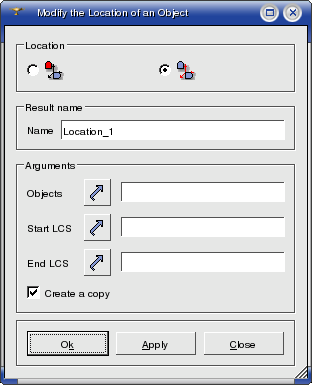 Modify the Location
Modify the Location Modify the Location
Modify the LocationTo Modify the Location in the Main Menu select Operations - > Transformation - > Modify the Location.
This operation modifies the Location of an Object.
The first algorithm places the object so that its center coincides with the center of an End Local Coordinate System.
Create a copy checkbox allows to keep the initial object, otherwise it will be removed.
Arguments: Name + 1 Object + End Coordinate System.

In the picture the initial cube with the global coordinate system is to the right and the modified cube with the Local Coordinate System in the center of it is to the left .

The second algorithm modifies the location of an object using Start and End LSC, although the final position of the object will not coincide with the center of either of the two systems. In this method the object is shifted from its initial position by the value of the remainder after subtraction of the coordinates of the Start LSC from the coordinates of the End LSC.
Create a copy checkbox allows to keep the initial object, otherwise it will be removed.
Arguments: Name + 1 Object + Start Coordinate System + End Coordinate System.

In this picture we see the initial cube with the global coordinate system and two LCS: LocalCS1 (GCS+100 along x-axis) and LocalCS2 (GCS+200 along x-axis)

|
Selecting Start LCS = LCS1 and End LCS = LCS2, we obtain the translated cube at the position (100;0;0)
|
Selecting Start LCS = LCS2 and End LCS = LCS1, we obtain the translated cube at the position (-100;0;0) |
|
|
|
TUI Command: geompy.MakePosition(theObject, theStartLCS, theEndLCS), where theObject is a shape, location of which is modified, theStartLCS is a location to move the shape from, theEndLCS is a location to move the shape to.
Our TUI Scripts provide you with useful examples of the use of Transformation Operations.